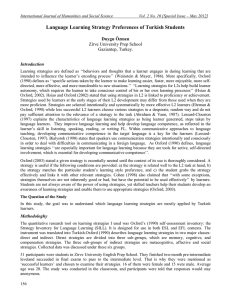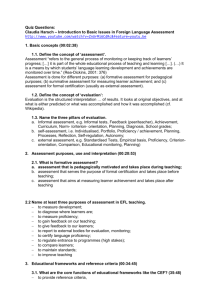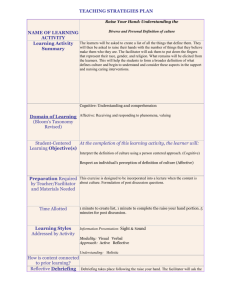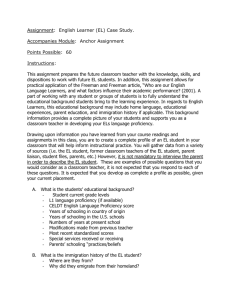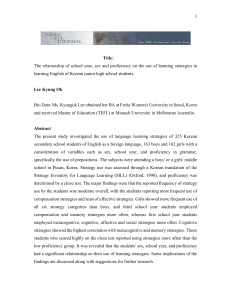Language Learning Strategy Use by Arabic
advertisement
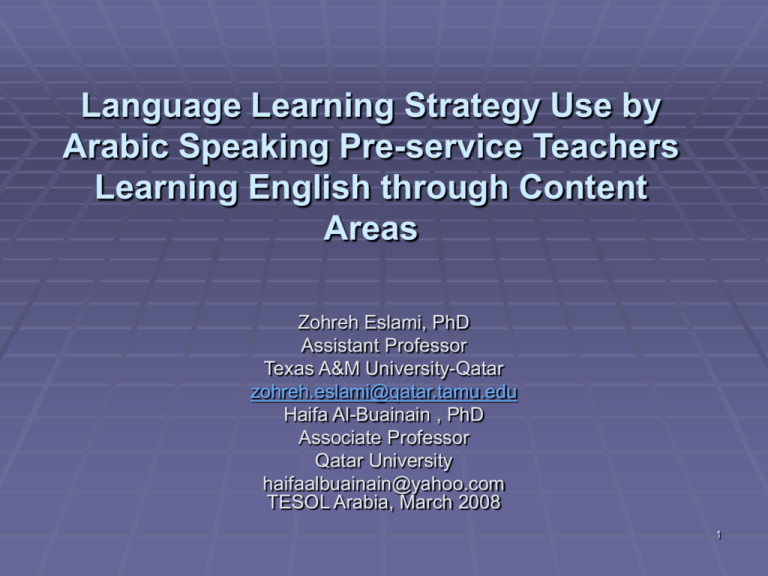
Language Learning Strategy Use by Arabic Speaking Pre-service Teachers Learning English through Content Areas Zohreh Eslami, PhD Assistant Professor Texas A&M University-Qatar zohreh.eslami@qatar.tamu.edu Haifa Al-Buainain , PhD Associate Professor Qatar University haifaalbuainain@yahoo.com TESOL Arabia, March 2008 1 Language learning strategies--Learner-initiated Learning strategies are a set of operations employed by the learner for acquiring, retaining, retrieving or performing— Rigney, 1978 Oxford (1990) said: “learning strategies are specific actions taken by the learner to make learning easier, faster, more enjoyable, more self-directed, more effective, more transferable to new situations” (p. 8). According to Stern (1992), “the concept of learning strategy is dependent on the assumption that learners consciously engage in activities to achieve certain goals and learning strategies can be regarded as broadly conceived intentional directions and learning techniques (p. 261). 2 Types of language learning strategies Rubin (1987) categorized language learning strategies into three types: a) Learning strategies, b) Communication strategies, and c) Social strategies. These 3 types of strategies are further divided into different groups of strategies. Basically the same types of strategies are recognized by other scholars such as Oxford, 1990, Stern, 1992,but they may somewhat be reorganized by other scholars. 3 Types of language learning strategies (con’t) Communication strategies: used by language learners in order to maintain the flow of an ongoing conversation. Social strategies: indirect learning strategies that do not lead to the obtaining, storing, retrieving, and using of language but can potentially lead to more opportunities of contact with the target culture or native speakers of the target culture. Affective strategies: things that language learners do and strategies they adopt in order to lower their learning anxiety or handle their emotional problems. 4 Past studies of language learner strategy use One important goal for examining language learning strategy use in past studies is to understand the cognitive, social, and affective processes involved in language learning in order to help the less successful language learners overcome learning difficulties (Chamot, 2001). The Strategy Inventory for Language Learning (SILL) developed by Oxford (1990) is widely used in the literature as a major instrument. Based on SILL, a 50-item (50 strategies) self-report questionnaire, language learning strategies are grouped into six categories: memory, cognitive, compensation, metacognitive, affective, and social strategies. 5 Past studies of language learner strategy use (Con’t) Research has clearly shown that all language learners use some kind of learning strategies, but depending on such factors as age, gender, and cultural origin learners differs in the type of strategies used and the frequency of use (Chamot & Kupper, 1989). Using SILL, studies that examined the use of language learning strategies among Asian students, for example, have found that compensation strategies were the most commonly used strategies by Chinese ELLs while memory strategies were the least used ones (Bedell & Oxford, 1996; Goh& Foong, 1997, Rong, 1999). Politzer and McGroarty (1985), on the other hand, compared Asian students with Hispanic students and found that Asian students tended to use fewer of the strategies associated with good language learners than did Hispanic students. 6 Past studies of language learner strategy use (Con’t) Oxford and Nyikos (1989) studied 1200 university students and found that females used language learning strategies more than their male counterparts. Green and Oxford (1995) found that the more proficient students adopted significantly more language learning strategies in the cognitive, compensation, metacognitive, and social categories. Ku (1997) arrived at similar conclusions in her study with 335 college students in Taiwan using SILL: the more proficient students in her study reported using learning strategies more often than the less proficient ones. Peacock (2001) found that students majoring in Physics used far less cognitive strategies than the math and engineering students, while math students used fewer metacognitive strategies Our Study???? 7 Research Questions 1. What types of language learning strategies are most frequently used by Arabic speaking pre-service teachers learning English through content areas? 2. Does the level of English language proficiency affect the students’ choice of language strategy and the frequency of use? 8 The study Participants:27 female Arab students enrolled in the Texas A&M and Qatar University PEPP (Primary Educator Preparation Program)teacher education program. The students were taking courses in the Texas A&M and Qatar University teacher education program. All the participants had a bachelor’s degree and were going through and intensive one year teacher education program. The medium of instruction for all courses was English. 9 Research Instruments Research Instrument: • Background questionnaire (including the self-reported language proficiency scale) • the Strategy Inventory of Language Learning (SILL) by Oxford (1990) • SILL contains 50 self-report question items regarding language learners’ frequency of language learning strategy use. For each of the questions, the participants are asked to respond on a five-point Likert scale ranging from 1 (never of almost never true of me) to 5 (always or almost true of me) The SILL is composed of two main groups of three strategies each as shown in the following: Direct Strategies: memory strategies, Cognitive strategies, and Compensation strategies Indirect Strategies: Metacognitive strategies, Affective strategies, Social strategies 10 Results Students reported using metacognitive strategies more frequently (M= 4.19) than five other types of English learning strategies. (table 1 and 2) Cognitive and social strategies tied in the second place (M= 3.81), followed by memory strategies (M= 3.62), compensation strategies (M= 3.76), and affective strategies (M= 3.23). Students’ level of English proficiency is found to be correlated with two compensation strategies, two metacognitive strategies, and one affective strategy. Students with higher levels of English proficiency, for example, reported that, they would use gestures when they cannot think of a word during conversation in English (C 25) and would use a word or phrase that has equivalent meaning as an English word that they cannot think of (C 29). 11 Results (Con’t) Students with higher levels of proficiency were also found to be more likely to notice their English mistakes and use that information to help them do better (D 31) and would try to find out how to be a better learner of English (D33) Students with higher levels of English proficiency were less inclined to talk to someone else about how they feel when they are learning English. 12 Discussion As discussed earlier, students’ level of English proficiency is found to be correlated with two compensation strategies, two metacognitive strategies, and one affective strategy. The result is in line with Klassen (1994) and Yang’s (1994) research results. These two studies, looking at students from Taiwan and China, also reported compensation strategies as being the most frequently used strategies. Our results have shown that students with higher levels of English proficiency tend to use more compensation and metacognitive strategies and therefore are more strategic about their language learning. The results have unique significance because language proficiency and its improvement has been cited as the most important area in feeling of self efficacy among NNESTs (nonnative English speaking teachers). 13 Discussion As Bremner (1999) suggests that the frequent use of compensation strategies might be due to the learning process. However, this situation may possibly result from that lower proficiency learners may not have sufficient confidence or enough language knowledge to make informed guesses. Thus, compensation strategies might be more readily available to learners with higher levels of proficiency. Affective and memory strategies were not used widely as reported by our participants. This result is similar with the results in Hong-Nam and Leavell’s (2006) study. In their study, they found that the least favored strategies by participants were affective strategies and memory strategies. These participants indicated that although they attempted to relax when they were uncertain about speaking English, their fears of making a mistake often kept them from trying. In more group oriented societies with a lot of emphasis one face and outside appearance, the affective factors may become more of a challenge for students. They may fear loosing ‘face’ and therefore do not use any affective strategies, and not use risk taking. 14 Discussion Memory strategies were the least frequently used strategies. Such reflection shows that learners are able to move beyond the basic levels of memorization of vocabulary and grammar (Hong-Nam & Leavell, 2006). It is hoped that as learners engage in more active management of their language learning strategy choices, they use less memory strategies. 15 References Bremner, S. (1999). Language learning strategies and language proficiency: investigating the relationship in Hong Kong. Canadian Modern Language Review, 55 (4), 490-514. Bedell, D. A. & Oxford, R. L. (1996). Cross-cultural comparisons of language learning strategies in the People’s Republic of China and other countries. In R. Oxford (Ed.), Language learning strategies around the world: cross cultural perspectives Chamot, A.U. (2001). The role of learning strategies in second language acquisition. In M. P. Breen (Ed.), Learner contributions to language learning (pp. 25-43). Harlow, England: Longman. Chamot, A. U. & Kupper, L. (1989). Learning strategies in foreign language instruction. Foreign Language Annals, 22, 13-24. Chang, S-J. (1990). A study of language learning behaviors of Chinese students at the University of Georgia and the relation of those behaviors to oral proficiency and other factors. Unpublished doctoral dissertation. University of Georgia, Athens, GA. Goh, C. C. M. & Foong, K. P. (1997). Chinese ESL students’ learning strategies: a look at frequency, proficiency, and gender. Hong Kong Journal of Applied Linguistics, 2 (1), 39-53. Green, J. M., & Oxford, R. L. (1995). A closer look at learning strategies, L2 proficiency and gender. TESOL Quarterly, 29 (2), 261-297. Hong-Nam, K. & Leavell, A. (2006) Language learning strategy use of ESL students in an intensive English learning context, System, 34( 3), 399-415. Klassen, J. (1994). The language learning strategies of freshman English students in Taiwan: A case study. Paper presented at the Third International Symposium and Book Fair on English Teaching, Taipei, Taiwan. Ku, P. Y. N. (April 1997). Predictors of strategy choice by EFL students in Taiwan. Paper presented at RELC Seminar, Singapore. Oxford, R. L., & Nyikos, M. (1989). Variables affecting choice of language learning strategies by university students. The Modern Language Journal, 73 (3), 291-300. 16 Oxford, R. L. (1990). Language learning strategies: What every teacher should know. Newbury House, New York. Peacock, M. (2001). Language learning strategies and EAP proficiency: teacher views, student views, and test results. In J. Flowerdew and M. Peacock (Eds.), Research Perspectives on English for Academic Purposes. Cambridge University Press. Rong, M. (1999). Language learning strategies of a sample of tertiary-level students in the P. R. China. Guidelines, 21 (1), 1-11. Rigney, J.W. (1978). Learning strategies: a theoretical perspective. In O’Neil Jr. H.F. (Ed.), Learning Strategies (pp. 165-205). Academic Press, New York. Rubin, J. (1987). Learner strategies: theoretical assumptions, research history and typology. In A. Wenden and J. Rubin (Eds.), Learner strategies in language learning (pp. 15-29). Englewood Cliffs, NJ: Prentice Hall Stern, H. H. (1992). Issues and options in language teaching. Oxford: OUP. Yang, N. D. (1994). Study of factors affecting EFL learners’ use of learning strategies: an investigating of Taiwanese college students. Paper presented at the Eleventh National Conference on TESOL, Taipei, Taiwan. 17


